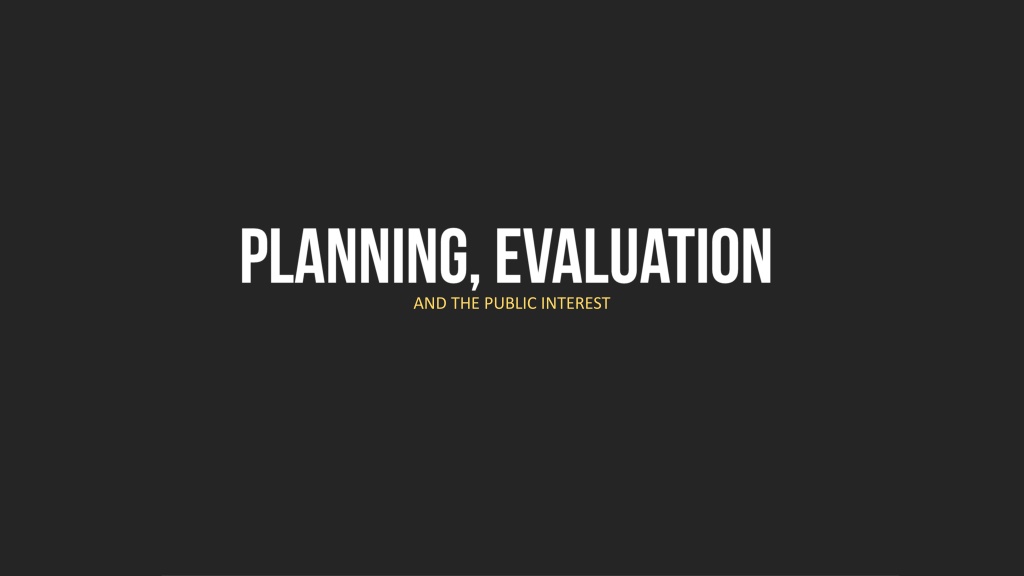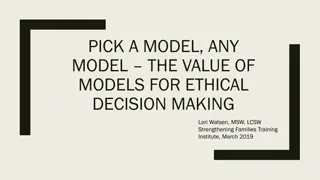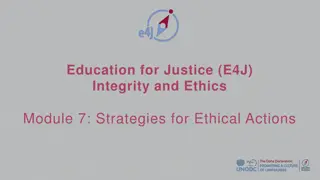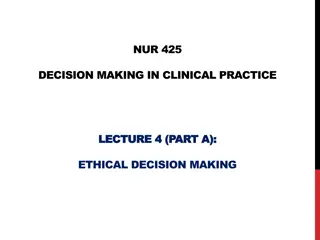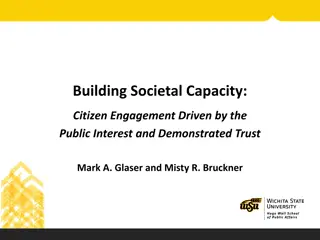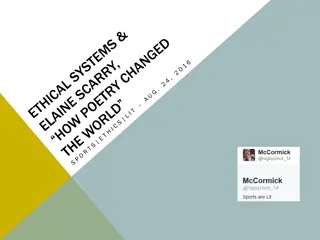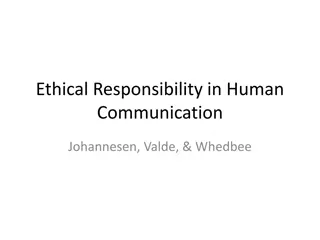Public Interest and Ethical Values
This content delves into the concept of public interest, ethical values, and the debate surrounding their existence as universal criteria. Arguments regarding individualism, pluralism, and the role of public interest in decision-making are examined. Contradictory viewpoints are presented, challenging the notion of a singular, overriding public interest. The discussion extends to the contributions from Lichfield and the need for balancing the public good with individual interests. Explore the complexities of evaluating values, systemic connections, and strategic decision-making in Chapter 5.
Download Presentation

Please find below an Image/Link to download the presentation.
The content on the website is provided AS IS for your information and personal use only. It may not be sold, licensed, or shared on other websites without obtaining consent from the author.If you encounter any issues during the download, it is possible that the publisher has removed the file from their server.
You are allowed to download the files provided on this website for personal or commercial use, subject to the condition that they are used lawfully. All files are the property of their respective owners.
The content on the website is provided AS IS for your information and personal use only. It may not be sold, licensed, or shared on other websites without obtaining consent from the author.
E N D
Presentation Transcript
APA ARGUMENNYA?: dari masing masing statement berikut: 1. Public interest does not exist as a fact! 2. The public interest does not exist as an extra-individual value! 3. Third argument: The public interest does not exist as a universal overriding value! APA KONTRIBUSI DARI LICHFIELD? KESIMPULAN? IS PUBLIC INTEREST AS A CRITERION IRRELEVANT ANY MORE ??
Argumen 1: Public interest does not exist as a fact??! There is no possible overlap among the various individual and group interests and desires Various individual and group interests are often explicitly and directly in conflict There was not any supervenient interest which all groups (or everybody) in society share in common Pluralism (of interests, desires, goals, and so on) as, simply, a fact a crucial fact that is clearly characteristic of (and strongly accentuated in) today s fragmented societies and cities. Pluralism here is something we can see and experience, especially in contemporary urban settlements.
Argumen 2: The public interest does not exist as an extra-individual value! Only individuals (as ends in themselves) should be taken into account when we refl ect on the justifi ability of government existence and action The moral individualist strongly asserts that it is only individual agents who matter in the design of socio-political institutions Liberal outlook / liberalism: Moral individualism >< moral universalism priority of right over good >< plurality of conceptions of the good basic individual rights >< rule of law
Argumen 3: The public interest does not exist as a universal overriding value Ethical value: it is impossible to accept and defend any substantive value as being strictly preferable to any single other . non-sceptical value-pluralism sceptical value-pluralism Kontribusi dari LICHFIELD: Intro of PBS and CIE 1. His acceptance of the fi rst two criticisms, 2. His rejection of the third criticism, 3. His belief that we need some idea of the public interest In planning you cannot please all the people all the time, so that some must suffer for the greater good, in the public interest .
s 1. Evaluation vs. Values 2. Systemic disconnectedness 3. Strategic Insubordination CHAPTER 5
CHAPTER 5 1. Bisakah proses evaluasi bebas dari nilai (value free)?? 1. the concept of value in evaluation that concerns us is typically (and implicitly) the economic 2. the behaviour of individuals, groups and communities is ruled by an axiomatic logic of utility which explains the behaviour leaving out the substantive values which determine such utility s
CHAPTER 5 1. Hasil: the value (neutral or implicit) as a basis for the evaluation. 2. Positivist analyst: evaluation depends on values >< Planological approach: values depend on evaluation? 3. how useful value could be as a guide to decisions depends strongly not on the value in itself but on the circumstances and the ways in which decisions are taken. s
CHAPTER 5 1. Relationship between values and evaluations 2. Evaluation process: level, paralel. Systemic interconnection of these two (or more) evaluation processes. 3. The necessity to respect some hierarchical criteria, either logical or institutional, where appropriate. s
CHAPTER 5 1. we need to affirm a certain hierarchy between evaluations and between the criteria that are used in any evaluation process 2. any evaluation process should aim at strategic consistency 3. methodological thinking exactly as planning science (or planology). 4. fixing the evaluation rules and criteria s
Cities appear more and more to be the sum of many isolated individuals The sense of community, of citizenship, is becoming a scarce public good The issue of human sustainable city development how do we design the new places of meeting , as inclusive public spaces ? That is, new spaces of participation, cooperation, community and hope (Sandercock, 2003)?
1. Promote relational/civic value, that is to promote behaviour as citizen , 2. Refer to the roots of a community, to its features/identity/singularity/tradition, 3. Stimulate new relations between history/memory, and innovation/ development.
1. 2. 3. 4. 5. 6. What to do ? How to do ? How much to do? Where to do ? With whom ? When to do?
1. economic/instrumental rationality helps in choosing the best use of disposable resources for maximizing the given objectives, formal/logic rationality, this helps to identify a coherent and a non- contradictory reference structure, argumentative rationality, this helps in choosing the goals of community & new values through public debate, communicative rationality, social communication processes, hermeneutical rationality recognizes the existence of implicit and intrinsic values emotional rationality, that recognizes values and meanings as facts, and stimulates connections between human beings and nature 2. 3. 4. 5. 6.
1. the spatial/physical distribution of impacts (direct, indirect, quantitative and qualitative) in a dynamic perspective, the distribution of impacts among economic, social, civil and public activities, the distribution of impacts among the different (economic, social and institutional) subjects. 2. 3.
1. ex-ante (before the event) and ex-post (after the fact) evaluation of plans/projects Benefi t-Cost Analysis multi-criteria method Planning Balance Sheet (PBS) Community Impact Evaluation (CIE) Territorial ImpactAssessment (TIA) 2. 3. 4. 5. 6.
